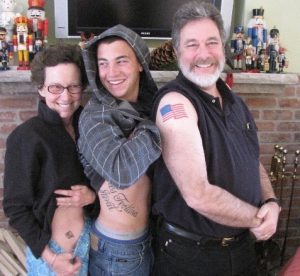The photo is from Christmas 2011. Our younger son, Derek, had recently completed training as a U.S. Marine and naturally acquired his first tattoo. As a surprise, my wife and I also got tattoos and the big reveal came that Christmas morning. (His older brother vowed that he wouldn’t join us unless and until the Chicago Cubs won the World Series—we’re still waiting to see that tattoo.) Having a tattoo is an occasional source of street cred when my students learn about it. It is also something we chose to do to mark a particular shared moment.
Markers of belonging are a central element of culture. Visible markers like tattoos or uniforms have a certain attraction, but it is the invisible ones that hold power; especially in organizations.
“Culture eats strategy for breakfast†is a phrase that pops up in organizational development circles with some regularity. More often than not it is attributed to Peter Drucker, although that appears to be unlikely. Regardless, culture is the way things work in an organization that won’t be found in employee handbooks or process maps. With a strong culture, everyone will do the right thing in the unanticipated moment. Put another way, culture defines what constitutes the right thing in the face of the new; accept it, reject it, play with it, deny it.
How does culture get reinforced and passed along if it can’t be found in the handbooks or the rules?
Today Derek is a sergeant responsible for the development of younger marines. If you study organizations you learn about sergeants. Having one in the family levels up those lessons. Sergeants are the primary caretakers of organizational health and culture. This isn’t something they talk or think about explicitly. It is the essence of the role and plays out in the way they carry themselves and in the stories that they share.
I was struck by the conversations we had at the end of his basic training. They were filled with stories of the history and traditions of the Corps. Huge amounts of time and effort were spent on why and how to be a Marine. It was designed into the experience. As Derek went off from training into the Fleet, these stories and experiences continued to be dispensed, primarily by sergeants.
We see this aspect of culture in the military and in the foreign places we travel. What is less easy to discern is that culture is not something that simply exists and is laid down during the distant origins of a place or an institution. Culture can happen organically in the ebb and flow of activity and the stories that sergeants and their equivalents opt to share. What institutions like the Marine Corps reveal is that strong cultures can be built and transmitted by design. They need to be anchored in the actual activity and experience of the organization; but we can choose which experiences are deemed worthy of emulating. As leaders we decide which markers to pass along.
